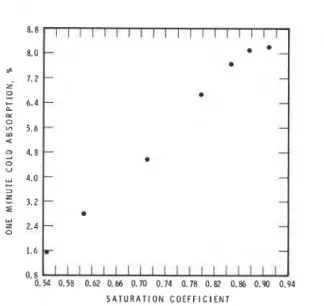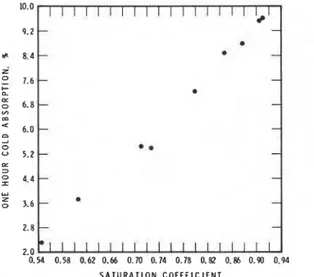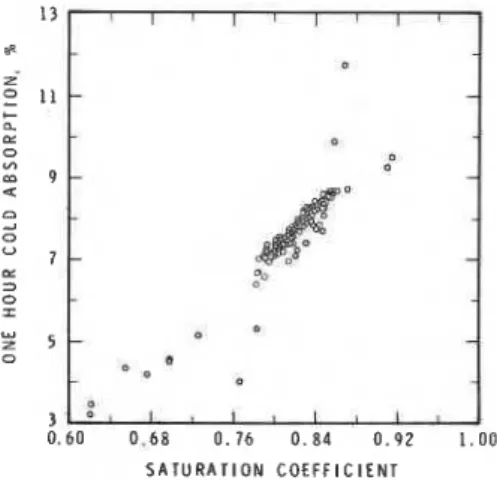Publisher’s version / Version de l'éditeur:
Vous avez des questions? Nous pouvons vous aider. Pour communiquer directement avec un auteur, consultez la première page de la revue dans laquelle son article a été publié afin de trouver ses coordonnées. Si vous n’arrivez pas à les repérer, communiquez avec nous à PublicationsArchive-ArchivesPublications@nrc-cnrc.gc.ca.
Questions? Contact the NRC Publications Archive team at
PublicationsArchive-ArchivesPublications@nrc-cnrc.gc.ca. If you wish to email the authors directly, please see the first page of the publication for their contact information.
https://publications-cnrc.canada.ca/fra/droits
L’accès à ce site Web et l’utilisation de son contenu sont assujettis aux conditions présentées dans le site LISEZ CES CONDITIONS ATTENTIVEMENT AVANT D’UTILISER CE SITE WEB.
Ceramic Engineering and Science Proceedings, 6, 11-12, pp. 1507-1512,
1985-11
READ THESE TERMS AND CONDITIONS CAREFULLY BEFORE USING THIS WEBSITE. https://nrc-publications.canada.ca/eng/copyright
NRC Publications Archive Record / Notice des Archives des publications du CNRC : https://nrc-publications.canada.ca/eng/view/object/?id=c87fd425-7dd7-479d-8342-11eaaec18b8a https://publications-cnrc.canada.ca/fra/voir/objet/?id=c87fd425-7dd7-479d-8342-11eaaec18b8a
NRC Publications Archive
Archives des publications du CNRC
This publication could be one of several versions: author’s original, accepted manuscript or the publisher’s version. / La version de cette publication peut être l’une des suivantes : la version prépublication de l’auteur, la version acceptée du manuscrit ou la version de l’éditeur.
Access and use of this website and the material on it are subject to the Terms and Conditions set forth at
Quality control of clay bricks
Ser
National Research Conseil nationalTH1 Council Canada de redrerches
Canada
N21d
no.
1369
Institute for Research in lnstitut de recherche ene, 2 Construction construction
E r n
Quality Control
of
Clay Bricks
by J.H. Kung and J.P. Storer-Folt
Reprinted from
The American Ceramic Society
Ceramic Engineering and Science Proceedings,
Vol. 6, No. 1 1-12, November-December 1985
p. 1507-1512
(IRC Paper No. 1369)
A ; ~ , " ; E Y Z E D
Price $2.00 NRCC 25853 NPK1-
CISTIBLDG.
MS.
L I B R A R Y
On peut, 3 l'aide du procCd6 d'absorption d'eau froide en une minute ou en une heure, r6duire la dur6e de l'essai de contrale de qualit6 bas6 sur les coefficients de saturation et visant 3
ddterminer la durabilith des briques d'argile. La prhcision des essais actuels de contrale de qualit6 peut &tre am6liorhe si on utilise 3 la fois le coefficient d'absorption et le coefficient de saturation.
Reprinted from Ceramic Engineering and Science Proceedings. Vol. 4 No. 11-12. November-December 1985 Copyright 1985 The American Ceramic Society
Quality
Control
of
Clay
Bricks
J. H. KUNG and J. P. STORER-FOLT National Research Council of Canada
M-20 Montreal Rd., Ottawa KIA 0 ~ & ~ a n a d a
The quality control test for the durability of clay bricks based on saturation coeflcients can be shortened using a one-min or one-h cold water absorption. The accuracy of current quality control procedures can be improved
if
both absorption and saturation c d c i e n t s are used together.Introduction
Despite the inadequacy of the standards on frost durability of clay bricks,' absorption and saturation coefficients continue to be used as quality con- trol criteria in the production of clay bricks. This may be due to the lack of an alternative method; also, because these procedures are simple, manufac- turers have established by experience the maximum allowable and the optimum
values for each of their products. However, quality control procedures based on absorption and saturation coefficients have other limitations. They are time consuming, typically requiring 48 h to obtain the saturation coefficient, and the values do not take into account the variations of raw material composi- tion. This paper describes an approach to shorten the experimental time and improve the accuracy of obtained results.
Short-Term Absorption Tests
The 48 h required to obtain the saturation coefficient make this an impractical quality control method in the present production of clay bricks. This lengthy period is especially undesirable in the case of continuous tunnel
kiln
operations, where advanced technologies are constantly increasing the push rate. By the time the saturation coefficient has been determined, hundreds of thousands of clay bricks have already been fired. Thus, the saturation coefficient in this case is only an index of the quafity of' bricks already produced; it is not a test that can be used as a corrective measure to adjust production in process.Many quick tests have been proposed and are used in production plants. The most common test is to measure the shrinkage of the size of the fired bricks, but this only represents a rough estimate of how well bricks were fired and cannot be used as an accurate quality control test for frost durability. The use of firechek keys* is another alternative, but the shrinkage obtained represents a direct measurement of the heat work and not a direct indication of the property of the fired brick. The most promising tests are the extended initial rate of absorption test2 and the abbreviated cold-water absorption tesk3s4 These tests still require hours and, in some cases, the validity of their application is unknown.
During the Industrial Research Fellowship Program sponsored jointly by the Clay Brick Association of Canada and the Division of Building Research,
National Research Council Canada, the possibility of using one-min or one-h cold water absorption as a quality control test was explored for nine different commercially marketed Canadian clay bricks. The experimental procedure is the same as the standard 24-h cold absorption test specified by ASTM C67. It was found that there was a correlation between the saturation coefficient and short-term cold abso,rption of laboratory-fired samples, as shown in Figs. 1 and 2. Subsequently, the
one-h
cold absorption was used as part of the routine quality control test in eight brick plants for further investigation. The results of this investigation confirmed that the short-term cold absorptions can be used as a substitute for the saturation coefficient; the degree of correlation was found to be a function of the mixing or the homogeneity of the raw materials. The correlation is best where one single source of raw material is used (Figs. 3 and 4) and poorest when different materials are blended (Fig.5); the degree of correlation appears to reveal the homogeneity of the mix.
In order to ensure the best correlation, short-term absorption tests should be done with half bricks or a fraction of a whole brick in order to avoid the "tight- skin effect" which increases the scatter of data. Although the initial rate of absorption could be measured in minutes, it proved to have a poorer correla- tion than the one-min or the one-h cold absorption tests and is more affected by surface texture.
If this test is to be used for quality control purposes, both the short-term cold absorption and the regular saturation coefficient should be measured initially for each type of brick.
Once
a proper correlation has been established, the short-term absorption test can be used as a quick and simple quality con- trol test provided the same raw materials and the same kiln are used. CompositeUse
of Cold Absorption and Saturation Coefficient for DurabilityCold absorption or saturation coefficients have been used separately for quality control, but their values vary depending on the raw material as well
as the kiln-firing condition. The inadequacy of using either one for accurate
quality control can be seen from Fig. 6. In a production plant, bricks of similar
saturation coefficient but different absorption, and similar absorption but
different saturation coefficient are both produced. These bricks have different properties. Thus, it is recommended that absorption and saturation coefficients be used in conjunction, because the composite relation is like a fingerprint of the brick.5 This relationship between saturation coefficient and absorption not only reveals the quality of the particular brick produced but also indicates
the history of the brick, such as the starting raw material composition and
the firing condition, as shown by Fig. 7 where the results for bricks of
known
compositions and firing conditions are plotted. For each raw material a proper index of durability should be d e f i e d
in
terms of the absorption and satura- tion coefficient and, as the raw material changes, the appropriate index must be determined for quality control.Conclusion
Current quality control tests for clay bricks based on saturation coefficient can be shortened by the use of one-min or one-h cold absorption tests. The accuracy of the quality control test can be improved further if both the absorp- tion and saturation coefficient are used together, since this composite rela- tionship reveals both the material composition and the firing condition.
Acknowledgments
The authors wish to thank the laboratory personnel at Brampton Brick Co. Ltd., Canada Brick Co. Ltd., Domtar Construction Materials Inc., I-X-L
Industries Ltd., L. E. Shaw Ltd., and Toronto Brick for their participation
and cooperation; to the Clay Brick Association of Canada for organizing the plant tests; and to G. W. Mould for his help in the analysis of data. This program was jointly sponsored by the Clay Brick Association of Canada and the Division of Building Research, National Research Council Canada. This paper is a contribution from the Division of Building Research, National Research Council Canada, and is published with the approval of the Director of the Division.
References
' G . C. Robinson, J. R. Holman, and J. F. Edwards, "Relation Between Physical Proper- ties and Durability of Commercially Marketed Brick," Am. Ceram. Soc. Bull. 56 [12] 1071-79 (1 ,-- 9771.
;D. L. Froberg, "Correlation of Extended Initial Rate-of-Absorption Test for 24-Hour Cold Water Absorption Properties of Brick," Presented at the 80th Annual Meeting of the American Ceramic Society, Detroit, MI (1978).
3H. B. Newman, "Direct and Indirect Methods of Measuring Body Maturity," Am. Ceram. Soc. Bull., 58 [6] 580-86 (1979).
4R. A. Prokopwicz and H. Dinh, "The Correlation of Short-Term Cold Water Absorption Data with Standard 24-Hour Cold Absorption Tests," Presented at the 79th Annual Meeting of the Canadian Ceramic Society, Toronto, Ont. (1981).
5J. P. Storer-Folt, Development of Low Energy Brick, I.E.R.D. Project Report NO. 41A/535-52/116 (1981).
*Bell Research Inc., Chester, WV.
8.8 1 1 1 1 1 1 1 1 1 1 1 1 1 1 1 1 1 1 1 8.0
-
a * 6 7 . 2 - Z 0-
c 6.4- L w 0 5 . 6 - m 4: a 4.8- 2 0 U , 4.0- c 3=
3 . 2 - I u z 2 . 4 --
0 1.6 r-
0.8 I l l l t l l 1 l 1 [ l l l l l l l l 0.Y 0.58 0.62 0.66 0.70 0.74 0.78 0.82 0.86 0.90 0.94 S A T U R A T I O N COEFFICIENTFig. 1. Correlation between 1-min cold absorp- tion and saturation coefficient for burned bricks from Project R.
1 1 1 1 1 1 1 1 1 1 1 1 1 1 1 1 1 1
0.54 0.58 0.62 0.6 o.m 0.73 0.78 0.82 0.a 0.90 0.94 S A T U R A T I O N C O E F F I C I E N T
Fg
.
2. Correlation between 1-h cold absorption and saturation coefficient for burned bricks fromProject R.
8 ' 1 ' 1 4 1 ' 1 '
0.50 0.58 0.66 0.74 0.82 0 . 9 0
S A T U R A T I O N C O E F F I C I E N T
Fig. 3. Relationship between saturation coefficient and absorption of bricks made from a single source of raw material.
S A T U R A T I O N C O E F F I C I E N T
Fig. 4. Relationship between saturation coefficient and absorption of bricks made with additives introduced in slurry.
S A T U R A T I O N C O E F F l C l E N l
Fig. 5. Relationship between saturation c d c i e n t and absorption of bricks made from blending a shale and a clay.
Fig. 6. Properties of bricks produced in a plant over a period of three months.
0 . 8 6 0 . 8 4 0 . 8 2 0 . 8 0
.'
LIMESTONE CONENT KILN N O . - 1 0 3-
d --
0 . 6 0 0 . 6 8 0 . 7 6 0 . 8 4 0 . 9 2 1 . 0 0 S A T U R A T I O N C O E F F I C I E N TFig. 7 . Effect of raw materials elucidated by plotting cold absorption vs saturation coefficient. 0 . 7 8 0 . 7 6 L -
a
- 0 1 I t I I I-
7 5 8 . 0 8 . 5 9 . 0 9 . 5 1 0 . 0 1 0 . 5 1 1 . 0 C O L D A B S O R P T I O N , %T h i s p a p e r i s b e i n g d i s t r i b u t e d i n r e p r i n t form by t h e I n s t i t u t e f o r R e s e a r c h i n C o n s t r u c t i o n . A l i s t of b u i l d i n g p r a c t i c e and r e s e a r c h p u b l i c a t i o n s a v a i l a b l e from t h e I n s t i t u t e may be o b t a i n e d by w r i t i n g t o t h e P u b l i c a t i o n s S e c t i o n , I n s t i t u t e f o r R e s e a r c h i n C o n s t r u c t i o n , N a t i o n a l Research C o u n c i l o f C a n a d a , O t t a w a , O n t a r i o , K1A 0R6. Ce document e s t d i s t r i b u 6 s o u s forme de t i r e - 3 - p a r t p a r 1 ' I n s t i t u t de r e c h e r c h e e n c o n s t r u c t i o n . On p e u t o b t e n i r une l i s t e d e s p u b l i c a t i o n s de l l I n s t i t u t p o r t a n t s u r l e s t e c h n i q u e s ou l e s r e c h e r c h e s e n m a t i e r e d e b a t i m e n t e n e c r i v a n t 3 l a S e c t i o n d e s p u b l i c a t i o n s , I n s t i t u t de r e c h e r c h e e n c o n s t r u c t i o n , C o n s e i l n a t i o n a l d e r e c h e r c h e s du Canada, Ottawa ( O n t a r i o ) , K1A OR6.



